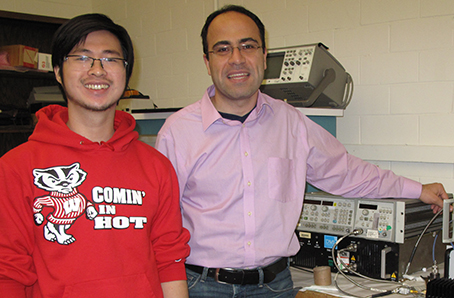
Nader Behdad: Restless energy
From an insect-inspired navigation system to cancer-fighting probes, Nader Behdad is about to break a few rules.
Nader Behdad’s laboratory in Engineering Hall seems to buzz with a hundred ideas. Boxy power amplifiers line the back wall while copper clippings curl across the tabletop. A partition in the middle of the room – for firing electromagnetic waves – requires a little footwork.
An entrepreneur, inventor and father, Behdad is happy juggling a caseload of students and collaborations. He has been involved with the Accelerator Program on several different projects since joining UW-Madison in 2009.
Behdad’s journey to Wisconsin crisscrosses continents. Originally from Iran, he graduated from Michigan and found himself turning down a job offer in the biomedical sector. After a stint in Florida he returned to the Midwest academic life.
Along the way he’s learned that frustration can bear fruit. Behdad has devoted countless hours to studying electrically ‘small’ antennas (small relative to the electromagnetic wavelengths that they receive and transmit). After eight years and a Ph.D., he felt he’d hit a wall of physical limitations.
“We can’t beat the laws of physics,” he says. “But the demand is out there.”
From inconspicuous military communication systems to the innards of a cell phone, the demand to create ever smaller antennas continues to push the bounds of reality.
In a stroke of insight, Behdad has looked to nature for a solution. He points to Ormia ochracea, a small fly native to the southern United States. Despite its minute size (its ears are separated by a mere half millimeter), the bug can precisely identify where a sound is coming from down to a degree or two. This is called super resolving directional hearing.
“We looked at these insects and tried to figure out how they accomplish this,” Behdad says. “We designed so-called biomimetic antennas based on the concept.”
Support from the Accelerator Program is helping his team build a proof-of-concept prototype. Applications include military tracking and civilian navigation systems. For example, Behdad describes a kind of indoor GPS device for triangulating one’s position within a building.
In upcoming field tests, the team will take the antennas outside and try to pinpoint various FM broadcast stations scattered across Madison.
Back in Engineering Hall, Behdad’s conversation turns to another topic. He brandishes a handful of what resemble slender glass needles. Actually they are antennas, designed to be inserted into a cancer patient and emit microwave radiation.
“Think about your microwave oven,” says Behdad. “It’s exactly the same physical phenomenon. But instead of an oven, we have tiny antennas that we embed in cancerous tissue to cook it.”
Raise the temperature of diseased tissue to about 60 degrees Celsius and cells begin dying within seconds.
But not all microwave ablation antennas are created equal, Behdad explains. One of the probes (stained with a recent liver sample) is slimmer than the others. This is because it isn’t attached to a device called a balun, a kind of conductor that surrounds the main antenna and prevents electric currents from running along the shaft and burning surrounding tissue.
The attachments have been necessary for years, until a team consisting of Ph.D. student Hung Luyen and his advisers Nader Behdad and Susan Hagness designed a balun-free antenna that is safe and less invasive. Their design utilizes a natural chokepoint to stifle any stray current.
“It’s the difference between inserting a thick needle into the body versus a very fine one,” says Behdad.
But thinner antennas are only the beginning. The most remarkable improvement is invisible. Several years ago, discounting decades of precedent, Behdad and Hagness began investigating higher frequencies.
“Over the past 20 or 30 years almost all engineers ignored one interesting concept,” Behdad says. “Everybody was looking at relatively low frequencies, the same ones that your microwave oven works at.”
The field had long believed that this low frequency, long wavelength energy works best because it is able to penetrate deeply into tissue. Crank up the frequency and the energy fails to penetrate, said the consensus.
But Behdad and Hagness started looking at frequencies in the 10 gigahertz range (roughly 10 times higher than conventional wisdom). Intriguing computer simulations were followed by promising experiments and surprising blackboard physics.
“No one had done the comparison we had done,” Behdad says. “It was the first experiment that showed that using higher frequencies had merit.”
Merit, and one groundbreaking advantage.
“At higher frequencies the antennas can become smaller,” he says.
So small they may one day be routed through a vein or twined through catheters to reach tumors of the lung, liver or kidney.
The therapeutic potential for slimmer, smaller antennas is vast. But there is much work yet to be done and WARF is helping. So far the experiments have been ex vivo, using dead tissue. Behdad, Hagness and their team now want to run tests in blood perfused liver samples, then progress to studies in animals.
“Support from the Accelerator Program has been very helpful,” says Behdad. “Especially with some of the applied parts of the work that are really important for commercialization.”
The team recently completed a large-scale study comparing their new designs against antennas on the market. Behdad says his past experience in the Accelerator Program has taught him that a good technical solution may not be enough to attract interest from large industry players. He says he is actively interested in a startup.
“This is something we can design and build,” he says. “Our main focus is to set up a company and commercialize it ourselves.”
Does he find time to sleep?
“Part of the reason I’m working on so many different things is that after a while I get bored and need to find new things to do,” he laughs.